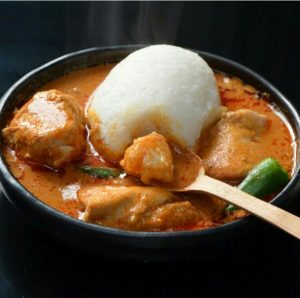 This Spring, I will be traveling to Ghana where I am excited to try as much local food as I have the time to eat. I expect to encounter Omo tuo, which is a Ghanaian staple food made by grinding and rolling rice into large, soft balls. Omo tuo is usually eaten by tearing apart the balls of rice with your fingers in order to dunk the pieces into peanut or groundnut soup, and it became rather popular in Ghanaian society due to the simplicity of its recipe.
This Spring, I will be traveling to Ghana where I am excited to try as much local food as I have the time to eat. I expect to encounter Omo tuo, which is a Ghanaian staple food made by grinding and rolling rice into large, soft balls. Omo tuo is usually eaten by tearing apart the balls of rice with your fingers in order to dunk the pieces into peanut or groundnut soup, and it became rather popular in Ghanaian society due to the simplicity of its recipe.
Ghanaian independence, which started in 1957, led to a massive increase in dietary consumption of rice in the country, particularly in urban areas. The new trend of rice consumption was brought about by an increased and more stable income, advantageous government pricing policies, the convenience of storing rice, and of course the simplicity of rice cooking. After gaining independence from such intensive colonial influence, the Ghanaian government wanted to shift primary food sources to such that could be grown on Ghanaian soil rather than imported, helping to improve the reality of the Ghanaian economy. Ironically, however, Ghanaian society has popularized rice consumption to such a degree that they cannot satiate the current rate of rice consumption with exclusively Ghanaian-grown rice. Ghanaian citizens actually prefer to not eat locally grown rice due to its poor production quality which most believe was the result of the country scrambling to produce enough rice after independence. Most rice is actually purchased from larger trade centers like Accra, the Ghanaian capital. In order for Ghana to be wholly self-sufficient in rice production, they must technologically adapt to more conservative ecological irrigation methods.
After the experience of industrialization through colonialism, food history in Ghanaian society shifted. To use rice as an example, people wanted to consume clean, pure rice produced en masse, leading brown rice to be perceived as dirtier or less polished than white rice. Most all Omo tuo is made with white rice as a cultural result. The whiteness is associated culturally with a perceived modernity or richness. Culturally, it is considered much more favorable to present guests with white rather than brown rice. Some food scholars believe this issue is also fueled by the subtle racism in colonial Ghana, but others dismiss this conclusion.
Omo tuo is such a popularized staple in Ghanaian culture that restaurants across the country boast Omo tuo as a special on Sundays. During my Omo tuo research, I could never find an origin story for the particularly Sunday tradition, rather I found hundreds of Facebook and Instagram invites to Ghanaian restaurants, boasting the Omo tuo special. Most of the Ghanaian population adheres to Christianity religiously, making Omo tuo consumption after Sunday morning service an extremely popular Ghanaian practice, indicating the breadth of colonial influence on the culture. Omo tuo is known to be eaten when people meet to watch football, or American soccer, together on Sundays.
I am really excited to travel to Ghana and try Omo tuo for myself, especially now that I understand its rich relationship with Ghanaian history.
